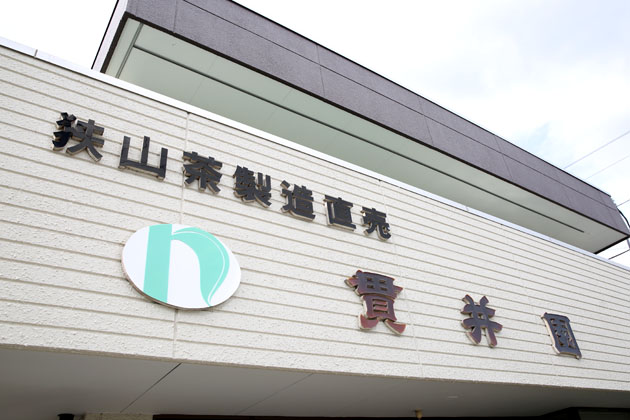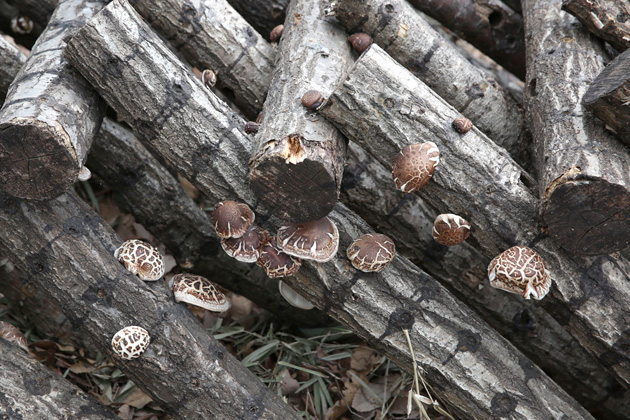
Nukuien’s Log-Grown Shiitake Mushrooms
Tell us about the log-grown Shiitake mushrooms.
NukuienLog-grown Shiitake are mushrooms grown with log cultivation. Log cultivation involves inoculating Shiitake spawn into natural broad leaf tree logs and you cultivate them by adjusting the temperature and humidity.
Could you go over the steps taken in the cultivation process?
NukuienFirst, from around January to when the cherry blossoms fall in April, we inoculate Shiitake spawn into about 200 oak logs every day. We make holes using drills and we hammer in the Shiitake spawn called "plug spawn" into these holes. We call these inoculated trees as "Hodagi".
 |
 |
| Plug spawn is hammered into the log. | The holes are sealed with wax or Styrofoam. |
It's still quite cold during the time when we inoculate, so we hermetically seal these Hodagi with plastic sheets and store them. Around June, we uncover the plastic sheets and we take these Hodagi out by hand to improve ventilation. As we continuously adjust the environment according to the season, Shiitake mycelium spreads through out the Hodagi and, after a year and a half, Shiitake mushrooms are ready to grow. This mycelium is like the parents of Shiitake and in fall and spring, their children, the "fruiting body," comes out of the log, spreading their spores and multiplying. These children turn into Shiitake mushrooms. Shiitake will grow by adjusting the temperature and humidity, recreating the ideal environment for the spawn to spread. It takes about 2 years from inoculating the logs to harvesting the Shiitake mushrooms; Growing Shiitake is a long and slow process.

What's the reason behind Nukuien's log cultivation?
Nukuien80% of the Shiitake mushrooms circulating in Japan are grown from sawdust cultivation, a cultivation method that uses blocks composed of sawdust to inoculate spawn. In this way, you can stabilize the production throughout the year, and also the period it takes to harvest is shorter, which works in favor for the producers and retailers. That is the reason why many producers are moving away from the traditional log cultivation towards sawdust cultivation. However, by cultivating using real wood like how Shiitake mushrooms grow in natural environment, we believe that we can grow tastier Shiitake mushrooms. So we only make Shiitake from log cultivation, up to this day.
Tell us the difference between Shiitake grown from sawdust and logs.
NukuienShiitake mushrooms are mainly composed of water and fiber. With sawdust cultivation, the mushrooms grow quickly in a very humid environment so they are moist, fluffy, and light. However, with log cultivation, the mushrooms grow slowly, breaking down the wood's nutrients over a period of time. The fiber becomes finer and they grow into thick, dense, and heavy Shiitake mushrooms. They are chewy and have a great aroma.
In which season can we get the most delicious log-grown Shiitake from Nukuien?
NukuienNormally, spring and fall are the seasons for Shiitake mushrooms. But even in the winter time when things don't sprout, with some human effort we can grow mushrooms that are chunkier than ones harvested in spring or fall. We mainly produce and harvest them for 9 months, from September to June. So, we recommend Shiitake mushrooms that are harvested between winter and early spring. During the warm seasons, mushrooms grow fast and the caps also open quickly, so the they don't become thick. On the other hand, during the cold seasons, mushrooms grow slowly without opening up their cap, and you get Shiitake mushrooms that are thick and dense.
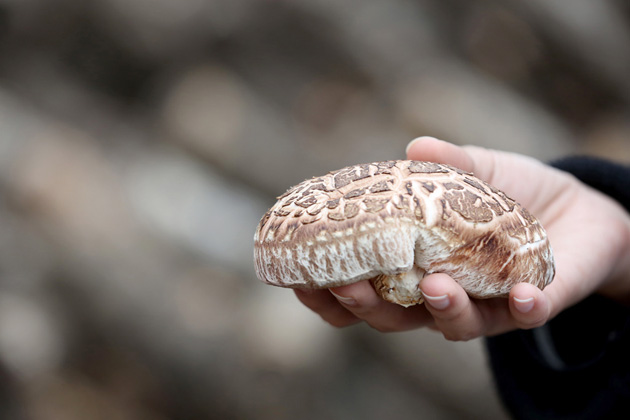
How many logs do you use for the cultivation?
NukuienEach year, we usually get 13000 – 15000 logs inoculated, and once Shiitake mushrooms begin to grow on them, they last from 1 – 4 years, so we have around 30000 logs in total. We utilize these 30000 logs according to the characteristics of Shiitake mushroom strain and the time they grow.

Shiitake spawn stick to dead trees and grow by breaking down and absorbing their nutrients. Gradually the log becomes brittle, and when it becomes crumbly and light enough for you to pick it up with one hand, Shiitake mushrooms can no longer grow on it.
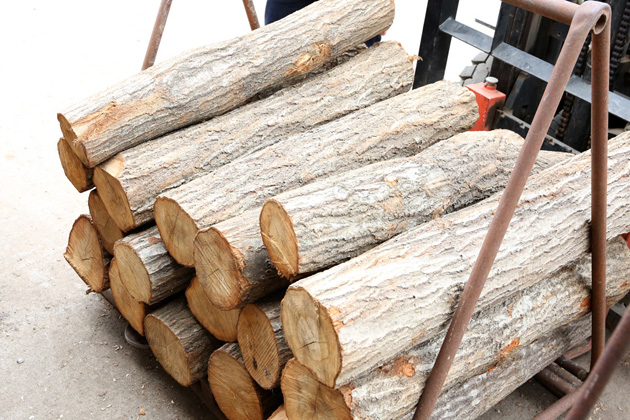 |
 |
| Logs before inoculation. | Logs inoculated for several years. |
How many mushrooms can you harvest from a single log?
NukuienYou can harvest around 1 kg of Shiitake mushrooms from a single log. It's not like you can harvest 1kg at once, but you get around 400 g for the first harvest. Next, you get 300 g, and then gradually decreasing to 200 g and down to 100 g.
Raw Shiitake mushrooms have smooth caps while the dried Shiitake caps usually have cracks in them. Are they from different strains?
NukuienThey're both from the same strain but depending on the cultivation environment, they are separated to raw or dried consumption.Shiitake mushrooms that grow on Hodagi in the forest have dry and hard surface, making them more suitable for dried Shiitake rather than for raw consumption. The caps aren't cracked at the beginning, but like how people's skins dry up and fracture during the winter season, the same thing happens to these mushroom heads when left outside. The ones with cracked but closed caps are called "Hana Donko," and are considered the highest grade dried Shiitake mushrooms that can only be produced in winter and spring.
 |
| Dried Shiitake mushrooms cultivated outdoors. |
By soaking 100 or so forest Hodagi in water for one night, each day, you can cultivate raw Shiitake inside green houses, with appropriate temperature and humidity. They are cultivated in an environment where the humidity is higher than in the forest, so the caps don't crack and stay moist and juicy.
 |
 |
| Hodagi inside a green house. | The caps of the raw Shiitake mushrooms aren't cracked. |
Are there anything in particular that you pay attention to while cultivating Shiitake mushrooms?
NukuienFirst, we are always taking great care of providing a comfortable environment for the spawn to spread. Mycelium is the string-like thing growing within the tree, which we cannot see nor does it express emotions. That's why when we, humans, feel a little chilly, we cover the mushrooms up with plastic sheets. And when we it feels hot and sweaty outside, the spawn are feeling the heat as well, so we reassemble the logs to increase the ventilation. Also, Shiitake spawn won't spread nor grow without rainfall, so when it doesn't rain much and looks as if they need water, we sprinkle them with some.
 |
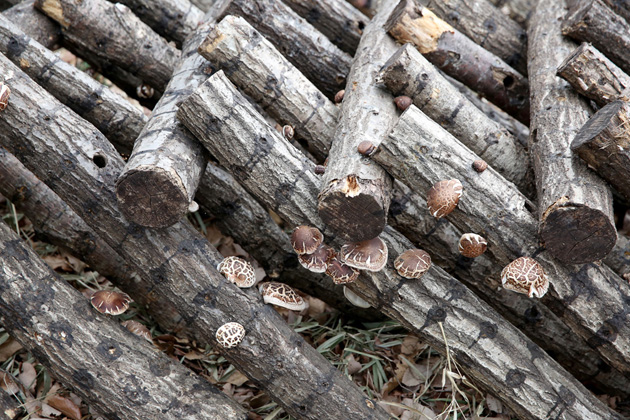 |
| Hodagi covered in plastic sheets. | Hodagi reassembled to increase ventilation. |
In addition, raw Shiitake mushrooms in green house need to be grown in dimly-lit environment. Shiitake mushrooms with short stalks and firm caps are considered ideal, but the stalks become longer if it's too dark. Obviously, it is ideal to grow them in mountains and forests that are similar to their natural growing environment, with low temperature, and moderate lighting.
 |
| Inside the green house. |
Are there years with good harvest and poor harvest for Shiitake mushrooms?
NukuienThere are some years when the amount of rain is perfect and we get a good harvest. Also, this doesn't really depend on the condition of the year, but there are times when we screw up the temperature and humidity adjustments. We end up ruining several hundred logs with Shiitake spawn, while wondering, "Why aren't any mushrooms growing on these logs?" In addition, one out of several Hodagi may end up as a failure, unable to produce Shiitake.

What makes Nukuien's Shiitake mushrooms distinct?
NukuienIt's not the case that every log-grown Shiitake mushrooms taste good. We first need to grow them with love and care. And the freshly picked ones are denser and taste better. But as time goes by, the molecules are loosened and they become squishy, dropping the quality. So at our store, we take "the timing when the customers taste our produce" into our foremost consideration and we offer them through direct sales. If we were to sell them through another companies or markets, it takes time until the produce is out on the shelves. And they may not have any problem selling expired Shiitake mushrooms that have past 3 days from harvest, which we would usually pull off the shelves. Actually, they can last up to 10 days, refrigerated. That's the reason why every morning at the local supermarkets where we ship our produce, we put freshly picked Shiitake mushrooms (picked on the day or the day before) out onto the shelves, ourselves. We put great emphasis on bringing our customers freshly-picked Shiitake mushrooms that taste the best.

How do you recommend preparing Nukuien's Shiitake?
NukuienShiitake mushrooms can be used as the main or side dish. You can have them in meat-stuffed peppers or you can slice them up in chunks and saute, deep fry, steam, or grill them; you can cook them in any way and enjoy them. And if you want to serve them to people who are not fond of Shiitake, you can make them into thin slices and stir-fry them with pork ribs and vegetables.
Nukuien
Address 〒358-0026 Saitama-ken, Iruma-shi, Koyata 2-1-19
Telephone & Fax number 04-2962-7372
Web page http://nukuien.com/eng/index.php
Online shop http://www.nukuien.co.jp/ (Only in Japanese)

